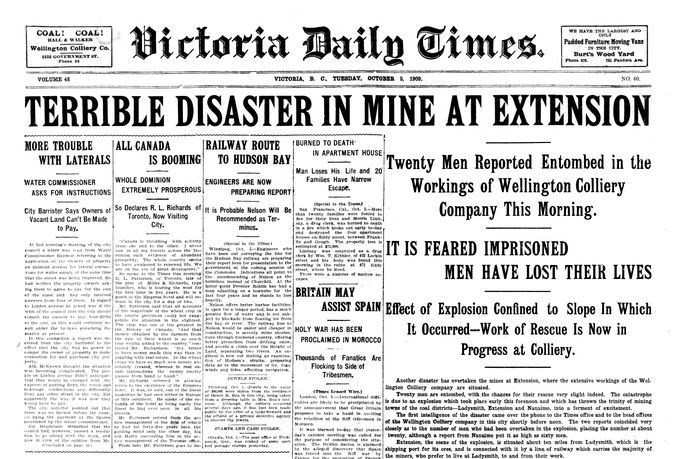One hundred and ten years ago, disaster struck at a coal mine on Vancouver Island.
“A terrific explosion occurred at Extension Mines of the Wellington Colliery Co. this morning about nine o’clock,” the Victoria Daily Times reported on Oct. 5, 1909. “Twenty men are entombed and it is feared have perished.”
Rescue parties were immediately dispatched.
“Fighting heroically against smouldering flames and deadly gas, the rescue parties have now penetrated a distance of fully three miles down No. 2 slope of the Extension mine, where the terrible explosion occurred yesterday,” the Vancouver World reported Oct. 6.
“Over 150 (miners) were engaged in attempts to rescue the bodies or save any who were fortunate enough to have survived the fire and gas that followed the awful explosion. (But) when the first five bodies were brought out at six o’clock yesterday all hope of saving any of the entombed miners was given up.”
Unfortunately, the initial estimate was low: 32 men had died in the disaster. Some were killed in the initial blast, others succumbed to gas.
Many of the miners lived in nearby Ladysmith, where trains brought the dead home.
“The most touching incident was probably the arrival of the body of Fred Ingham,” the World reported. “His sister and mother both went into hysterics when told Fred was among the dead. It was the second son which Mrs. Ingham has lost in these mines under the most distressing circumstances.
“Over three years ago another son, Menelus Ingham, received severe spinal injuries from a premature blast in this mine. For three long years he lay helpless on a water bed in the hospital, a hopeless case of spinal paralysis, before he finally succumbed to the end he often prayed would come.”
Among the other victims on Oct. 5 was Tom O’Connell, “the star fullback of the Ladysmith football team.”
“From the position in which his body was found it was evident that he had taken alarm at the first sound of the explosion and made a desperate effort to escape,” wrote the World’s W.F. Findlay.
“One of the men who escaped said O’Connell had called to him and then started to run to escape the deadly after-damp (toxic gases) which generally causes a greater loss of life than the explosion itself.
“He was found with his arms drawn up and his leg muscles still tense from the last desperate rush, more determined than he had ever been on a football field, in which he was trying to reach fresh air. In his mad rush he had dashed full tilt into a pillar in the darkness. The shock evidently stunned him and allowed the deadly gas to overtake him.”
The cause of the explosion was believed to be an explosion of coal dust.
“Mine inspector Sheppard said the only way that could have been caused was by a blown-out shot — a charge of dynamite so fired that it blew out of the tamping of the hole and spent its force on the air in the interior of the mine instead of dislodging the mass of coal into which it was drilled,” said the World.
The Oct. 5 explosion was the second disaster to strike the Extension mine that decade. A fire on Sept. 10, 1901 killed 17.
It was a brutal way to make a living. The Nanaimo Archives has a searchable database of mining accidents on Vancouver Island, and there are 81 matches for 1909.
Six more miners were killed in one of the three Extension mines that year — if you add the 32 killed Oct. 5, a total of 38 men were killed in the Extension mines in 1909 alone.
The worst disaster in the Vancouver Island coal mines was an explosion at the No. 1 mine in Nanaimo on May 3, 1887 that killed



